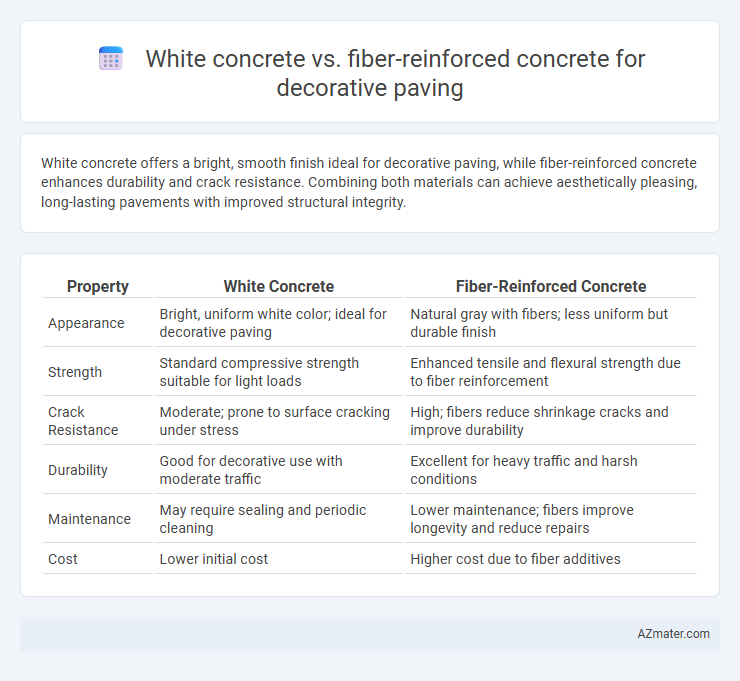White concrete offers a bright, smooth finish ideal for decorative paving, while fiber-reinforced concrete enhances durability and crack resistance. Combining both materials can achieve aesthetically pleasing, long-lasting pavements with improved structural integrity.
Table of Comparison
| Property | White Concrete | Fiber-Reinforced Concrete |
|---|---|---|
| Appearance | Bright, uniform white color; ideal for decorative paving | Natural gray with fibers; less uniform but durable finish |
| Strength | Standard compressive strength suitable for light loads | Enhanced tensile and flexural strength due to fiber reinforcement |
| Crack Resistance | Moderate; prone to surface cracking under stress | High; fibers reduce shrinkage cracks and improve durability |
| Durability | Good for decorative use with moderate traffic | Excellent for heavy traffic and harsh conditions |
| Maintenance | May require sealing and periodic cleaning | Lower maintenance; fibers improve longevity and reduce repairs |
| Cost | Lower initial cost | Higher cost due to fiber additives |
Introduction to Decorative Paving Solutions
White concrete offers a clean, bright aesthetic ideal for decorative paving solutions, enhancing outdoor spaces with its reflective properties and smooth finish. Fiber-reinforced concrete improves durability and crack resistance, making it suitable for high-traffic decorative pavements that require both strength and visual appeal. Combining these materials can optimize both design flexibility and structural performance in decorative paving applications.
Overview of White Concrete in Decorative Applications
White concrete in decorative paving offers a bright, reflective surface that enhances aesthetic appeal and reduces urban heat island effects, making it ideal for plazas, sidewalks, and driveways. Its high albedo improves light distribution while providing a smooth, versatile substrate adaptable to stamping, staining, or exposed aggregate finishes. Compared to fiber-reinforced concrete, white concrete excels in visual brightness and customization for architectural and landscaping designs.
Understanding Fiber-Reinforced Concrete
Fiber-reinforced concrete (FRC) enhances decorative paving by incorporating synthetic or steel fibers that improve tensile strength, crack resistance, and durability compared to traditional white concrete. This reinforcement reduces shrinkage cracks and increases impact resistance, making FRC ideal for high-traffic or load-bearing decorative surfaces. The use of fibers also allows for thinner slabs and more intricate design patterns without compromising structural integrity.
Aesthetic Qualities: White Concrete vs Fiber-Reinforced Concrete
White concrete offers a clean, bright appearance ideal for achieving sleek, modern decorative paving with excellent light reflectivity and color consistency. Fiber-reinforced concrete enhances surface texture and durability, creating intricate patterns and subtle visual depth while minimizing cracking and wear. Both materials allow for customization, but white concrete excels in achieving uniform aesthetics, whereas fiber reinforcement improves structural integrity without compromising design versatility.
Durability and Strength Comparison
White concrete offers moderate durability with a smooth finish ideal for decorative paving, but it may be prone to surface cracking under heavy load. Fiber-reinforced concrete integrates synthetic or steel fibers that significantly enhance tensile strength and resistance to cracking, making it more durable for high-traffic areas. The combination of improved flexural strength and reduced shrinkage from fibers ensures longer-lasting structural integrity in decorative paving applications.
Installation Processes for Both Materials
White concrete installation involves precise batching of white Portland cement and fine aggregates, requiring careful curing to prevent discoloration and ensure uniform appearance for decorative paving. Fiber-reinforced concrete incorporates synthetic or steel fibers during mixing, improving tensile strength and crack resistance, which simplifies the finishing process and reduces the need for jointing or additional reinforcement. Both materials demand proper subgrade preparation and curing techniques, but fiber-reinforced concrete offers enhanced durability and faster installation due to reduced shrinkage and cracking risks.
Maintenance Requirements and Lifespan
White concrete offers excellent aesthetic appeal for decorative paving but requires regular cleaning and sealing to prevent discoloration and surface wear. Fiber-reinforced concrete enhances durability and crack resistance, reducing maintenance frequency and extending the lifespan of paved surfaces. Its superior tensile strength helps maintain structural integrity, making it ideal for high-traffic areas with lower upkeep needs.
Cost Analysis: White vs Fiber-Reinforced Concrete
White concrete typically incurs higher initial costs due to the use of specialized white cement and pigments, essential for achieving its bright, aesthetic appeal in decorative paving. Fiber-reinforced concrete, while potentially less expensive per cubic yard, offers enhanced durability and reduced maintenance costs over time by minimizing cracks and structural damage. Long-term cost savings from fiber reinforcement can offset higher upfront expenses associated with white concrete, especially in high-traffic decorative paving applications.
Suitability for Different Decorative Styles
White concrete offers a clean, bright base ideal for modern and minimalist decorative paving styles, enhancing color vibrancy and achieving a sleek appearance. Fiber-reinforced concrete provides increased tensile strength and durability, making it suitable for intricate patterns and textured surfaces that require long-lasting structural integrity. Both materials support various decorative finishes, but fiber reinforcement excels in high-traffic areas where crack resistance and performance are critical.
Choosing the Best Concrete Type for Decorative Paving
White concrete offers a bright, clean base ideal for vibrant decorative paving, enhancing color contrast and aesthetic appeal. Fiber-reinforced concrete improves durability and crack resistance, ensuring long-lasting performance in high-traffic decorative paving applications. Selecting between white and fiber-reinforced concrete depends on prioritizing visual brightness or structural strength for the intended decorative pavement project.

Infographic: White concrete vs Fiber-reinforced concrete for Decorative paving
 azmater.com
azmater.com